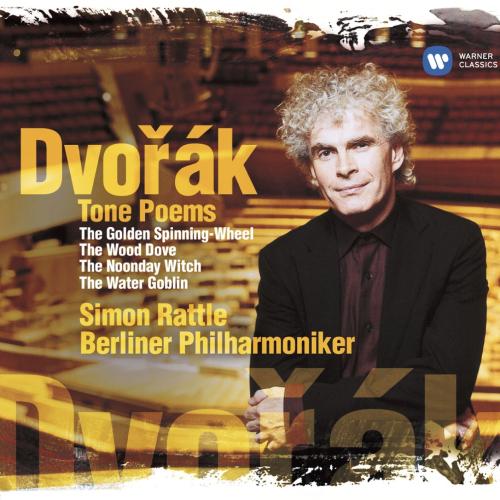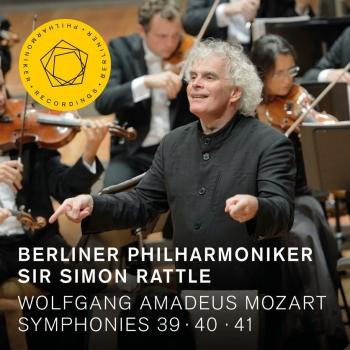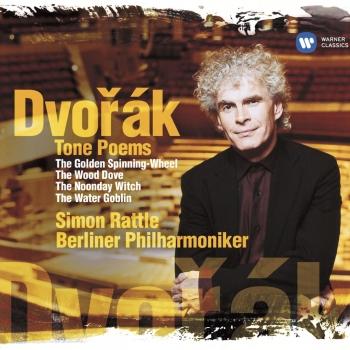
Dvořák: Tone Poems. The Golden Spinning-Wheel, The Wood Dove, The Noon Witch & The Water Goblin Berliner Philharmoniker & Sir Simon Rattle
Album info
Album-Release:
2005
HRA-Release:
09.01.2023
Label: Warner Classics International
Genre: Classical
Subgenre: Orchestral
Artist: Berliner Philharmoniker & Sir Simon Rattle
Composer: Antonin Dvořák (1841-1904)
Album including Album cover Booklet (PDF)
I`m sorry!
Dear HIGHRESAUDIO Visitor,
due to territorial constraints and also different releases dates in each country you currently can`t purchase this album. We are updating our release dates twice a week. So, please feel free to check from time-to-time, if the album is available for your country.
We suggest, that you bookmark the album and use our Short List function.
Thank you for your understanding and patience.
Yours sincerely, HIGHRESAUDIO
- Antonín Dvořák (1841 - 1904): The Golden Spinning Wheel, Op. 109, B. 197:
- 1 Dvořák: The Golden Spinning Wheel, Op. 109, B. 197: I. Allegro, ma non troppo 08:35
- 2 Dvořák: The Golden Spinning Wheel, Op. 109, B. 197: II. Molto vivace 06:40
- 3 Dvořák: The Golden Spinning Wheel, Op. 109, B. 197: III. Lento 06:24
- 4 Dvořák: The Golden Spinning Wheel, Op. 109, B. 197: IV. Allegro, ma non troppo 06:18
- The Wild Dove, Op. 110, B. 198:
- 5 Dvořák: The Wild Dove, Op. 110, B. 198: I. Andante. Marcia funebre 05:21
- 6 Dvořák: The Wild Dove, Op. 110, B. 198: II. Allegro 02:55
- 7 Dvořák: The Wild Dove, Op. 110, B. 198: III. Molto vivace 05:37
- 8 Dvořák: The Wild Dove, Op. 110, B. 198: IV. Andante 06:55
- The Noon Witch, Op. 108, B. 196:
- 9 Dvořák: The Noon Witch, Op. 108, B. 196: I. Allegretto 05:35
- 10 Dvořák: The Noon Witch, Op. 108, B. 196: II. Andante sostenuto e molto tranquillo 05:19
- 11 Dvořák: The Noon Witch, Op. 108, B. 196: III. Andante 02:44
- The Water Goblin, Op. 107, B. 195:
- 12 Dvořák: The Water Goblin, Op. 107, B. 195: I. Allegro vivo 07:00
- 13 Dvořák: The Water Goblin, Op. 107, B. 195: II. Andante mesto come prima 04:53
- 14 Dvořák: The Water Goblin, Op. 107, B. 195: III. Un poco più mosso 04:29
- 15 Dvořák: The Water Goblin, Op. 107, B. 195: IV. Allegro vivace 04:55
Info for Dvořák: Tone Poems. The Golden Spinning-Wheel, The Wood Dove, The Noon Witch & The Water Goblin
During his time as director of the Berlin Philharmonic Orchestra, Sir Simon Rattle has made several recordings on EMI Classics of repertoire new to both him and the orchestra. Last summer saw them taking on Messiaen's Éclairs sur l'au delà… and they brought in the New Year with a live recording of Carl Orff's Carmina Burana at the Berlin Silvester concert. Both recordings received worldwide acclaim in the press: "A definitive recording of an epic masterpiece." (Messiaen - The Observer); "…the orchestra here plays it as if it were its meat and drink… Stunning." (Orff - Classic FM magazine). Simon Rattle has now turned his attention to Antonín Dvo?ák, with this, his first recording of the Tone Poems, captured in live performances at Berlin's Philharmonie in March and June last year.
Dvorák is best known and loved for his 'New World' Symphony and Slavonic Dances and became the most well-known composer in his native Bohemia, the northern part of the Czech Republic. He is less well known for his collection of four Tone Poems, which were all written in 1896, towards the end of his life. The four Tone Poems are Holoubek (The Wild Dove), Polednice (The Noon Witch), Zlat˛ Kolovrat (The Golden Spinning Wheel) and Vodník (The Water Goblin). In spite of their innocent-sounding names, the Tone Poems are based on the gruesome poems of 19th-century Czech poet, Karel Jaromír Erben, who himself became an icon of Czech literature. The Wild Dove opens with a funeral procession and a widow following the coffin. We learn that she has poisoned her husband and she soon marries again. On her husband's grave, a tree grows and a wild dove appears in its branches. It seeks out the wife and its persistent cooing eventually drives her to madness and to suicide. Polednice tells of a mother who issues a typical parental warning to her only child, that if he does not stop crying the 'Noon Witch' will come to get him. No sooner has she made the threat, to her horror, the witch does arrive and in the mother's efforts to protect her son, she smothers him to death. Her husband returns home to find her cradling the dead child in her arms. The Golden Spinning Wheel sees a mother punished after she kills her stepdaughter to secure her own daughter's happiness in marriage. As she spins the wheel, her stepdaughter comes back to life piece by piece in golden thread, and takes her revenge by brutally killing the mother once she is whole. Perhaps the most shocking of all is the tale of the Water Goblin, who falls for a girl living with her mother by the lake he inhabits. He kidnaps her and against her will, they have a baby together. The girl's unhappiness leads the Water Goblin to allow her one last visit to her mother on the condition that she show no affection for her and that she leave the baby behind as hostage. But the mother won't let the girl return to the lake. After shutting the goblin out, the mother and daughter hear a thud on the door and open it to find the baby dead, and headless, on the doorstep.
The Tone Poems are rarely-performed works and this recording by Simon Rattle and the Berlin Philharmonic is a very special addition to their discography on EMI Classics.
"Rattle's readings of Dvorak's tone poems set a new standard" (BBC Music)
"Recorded with vibrancy and a wide dynamic range, these performances unquestionably lead the field….(Rattle) turns (these poems) into miniature orchestral opera with unfailing attention to dynamic detail." (BBC Music)
"Rattle has a large conception of these imaginative works, which are delivered with sonic splendor" (AudAud.com)
Berliner Philharmoniker
Sir Simon Rattle, conductor
Berliner Philharmoniker
Beginnings
Spring 1882: When Benjamin Bilse announces the intention of taking his already underpaid orchestra on the train to Warsaw in fourth class for a concert, that's the last straw for 54 of his musicians. Calling themselves the 'former Bilse Kapelle', they decide to declare their independence. But at first the young ensemble has economic problems of its own to confront, and it isn't until the Berlin concert agent Hermann Wolff takes over its organization in 1887 that a stable basis for the future is finally established. He changes the name to 'Berliner Philharmonisches Orchester', turns a renovated roller-skating rink into the first 'Philharmonie' and seeks out the best conductors of the day for his musicians.
The great orchestral trainers
Hans von Bülow has already formed a first-class ensemble from his Meiningen Court Orchestra when he takes over the Berliner Philharmoniker. In only five years at the helm he lays the foundation of those special musical qualities that from now on will be indissolubly linked with the orchestra's name. Bülow's successors, on the other hand, come to stay. Arthur Nikisch, who takes up his post in 1895, goes on to influence the orchestra's style decisively for the next 27 years. He once writes: 'It can be asserted without hesitation that in a first-rate orchestral body every member deserves to be described as an 'artist',' and with this creed he encourages the Berlin musicians to develop a sense of themselves as 'soloists'. That quality still represents one of the Philharmonic's unmistakable trademarks.
When Nikisch dies in 1922, the orchestra unanimously chooses Wilhelm Furtwängler to succeed him. The young conductor builds on Nikisch's achievements. His idiosyncratic beat and his impassioned, inspired music-making demand from the musicians an extremely high level of autonomy and sensitivity. Furtwängler's philosophy emphasizes the timelessness of great works of art, and thus his greatest affinity is for the Classical and Romantic masters. He and his Berlin orchestra become legendary interpreters of the works of Beethoven, Brahms and Bruckner. At the same time Furtwängler expands the repertoire to include contemporary pieces by Schoenberg, Hindemith, Prokofiev and Stravinsky.
The turmoil of war
The National Socialist dictatorship and the war do irreparable damage to the German cultural landscape – including the Berliner Philharmoniker. The regime’s maniacal racial policy leads to the loss of valuable musicians, and the orchestra finds itself isolated from the international exchange of soloists and conductors. Meanwhile there is also an attempt to turn Germany’s representative ensemble into an instrument of official cultural politics. Nevertheless Furtwängler and the orchestra manage to salvage its artistic substance through the war.
But the comparatively rapid turnover of conductors in the early post-war period speaks for itself. The Philharmonic under Leo Borchard already gives its first concert on 26 May 1945 in the Titania-Palast, a converted cinema, but in August, through a tragic mistake, Borchard is shot and killed by an occupying soldier. Chosen to succeed him is a completely unknown young Romanian, virtually straight out of the Berlin Music Hochschule, where he has been studying. But the orchestra’s judgment proves itself to be acute: Sergiu Celibidache arouses great enthusiasm with his vivid personality and widely varied programmes until 1952, when the orchestra’s leadership is officially returned to the hands of Furtwängler. Also coming in the postwar period is the founding in 1949 of the “Gesellschaft der Freunde der Berliner Philharmonie e.V. ” (Society of Friends of the Berliner Philharmonie Inc.), which in subsequent decades sponsors the building of the new Philharmonie and continues to provide the hall with financial support.
The Karajan era
In November 1954 Wilhelm Furtwängler dies. The following April the Berliner Philharmoniker chooses as its artistic director the man who is to remain with the ensemble longer than any other - Herbert von Karajan. He works with the orchestra to cultivate a specific sound, an unprecedented perfection and virtuosity which lay the groundwork for the ensemble's national and international triumphs - both in the concert hall and through countless recordings.
Moreover, Karajan is able to expand the orchestra's activities in a number of new directions. With the founding of the Salzburg Easter Festival in 1967 the orchestra now has its own major international festival and an opportunity to make its mark as an opera orchestra. A further initiative is the Orchestra Academy of the Berliner Philharmoniker (Orchester-Akademie der Berliner Philharmoniker), in which young and talented instrumentalists are trained through practical experience to meet the stringent demands of a top-flight orchestra. The construction of the new Philharmonie also takes place during the Karajan era. Since October 1963 the orchestra has made its home in the concert hall designed by Hans Scharoun, (to which a chamber music hall is added in 1987).
Claudio Abbado
Herbert von Karajan died in July 1989, after nearly 35 years as the orchestra's artistic director. His successor was a familiar face. Claudio Abbado conducted the Philharmoniker for the first time in 1966 and earned the musicians' highest esteem during the intervening years. He was not an orchestral trainer in the manner of his predecessors but led through the sheer force of his conviction and artistic presence.
Abbado's programmes brought a pronounced shift in emphasis. Each cycle of concerts was given a thematic focus – for example, 'Faust', 'The Wanderer' or 'Music is Fun for All'. This conceptual modernisation corresponded to a significant rejuvenation of the Philharmoniker themselves. Well over half of the current membership joined the orchestra during this time. In February 1998 Claudio Abbado announced that he would not renew his contract beyond the 2001/2002 season, and in June of the following year the Berliner Philharmoniker elected a new chief conductor by a wide majority.
Sir Simon Rattle
With Sir Simon Rattle's appointment, the orchestra not only succeeded in recruiting one of the most talented conductors of the younger generation but also in introducing a series of important innovations. The conversion of the orchestra into a public foundation, the Stiftung Berliner Philharmoniker, on 1 January 2002 has provided a modern structure which allows a broad range of opportunities for creative development while ensuring the ensemble's economic viability. The foundation enjoys the generous support of the Deutsche Bank, its principal sponsor. One focus of this sponsorship is the education programme established when Sir Simon Rattle assumed his post and through which the orchestra addresses a broad public – young people in particular. Sir Simon Rattle has summarised his intentions as follows: 'The education programme reminds us that music is no mere luxury, but instead a fundamental need. Music must be a vital and essential element in the life of each individual.' In the 130-year history of the Berliner Philharmoniker this represents an expansion of the orchestra's cultural mandate, one to which they are dedicating themselves with characteristic commitment.
For this commitment the Berliner Philharmoniker and their artistic director were appointed as international UNICEF Ambassadors, an honour conferred for the first time on an artistic ensemble. In June 2011 the Berliner Philharmoniker and Sir Simon Rattle received the Glashütte Original Music Festival Award for their educational programming and their role as a model for the programmes of other cultural institutions.
As a result of the Berliner Philharmoniker Foundation's desire to open up the Philharmonie to wider sections of the population and make it an attractive location during the day as well, two new concert formats were launched during the 2007/2008 season. During the free Lunchtime Concerts presented every Tuesday in the Foyer of the Philharmonie, outstanding chamber music works are performed by ensembles from the Berliner Philharmoniker, the city's universities and other Berlin orchestras. In the chamber music series Alla turca, artists from the Orient and Occident came together for cultural dialogue and introduced their music, exploring the historical and cultural differences of the two cultures. Beginning with the 2011/2012 season, Alla turca was expanded to Unterwegs (Underway), a new world music series developed and presented by Roger Willemsen. Together with their partner, the Deutsche Bank, the Berliner Philharmoniker initiated a forward-looking project in January 2009: the Digital Concert Hall. Concerts by the Berliner Philharmoniker can now be enjoyed live in the Internet and retrieved from the video archive of the Digital Concert Hall at any time.
In spring of 2012 the Berliner Philharmoniker appeared for the last time at the Salzburg Easter Festival. In 2013 the orchestra will launch its new Easter Festival in Baden-Baden, with four opera performances each year, symphonic concerts and a wide array of chamber music programmes. In addition, the orchestra will also devote itself particularly to encouraging young musicians and artists.
Booklet for Dvořák: Tone Poems. The Golden Spinning-Wheel, The Wood Dove, The Noon Witch & The Water Goblin















